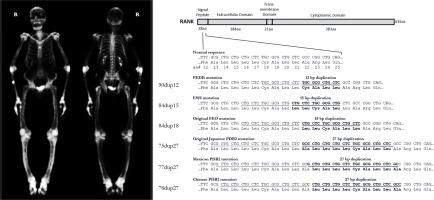Our official English website, www.x-mol.net, welcomes your
feedback! (Note: you will need to create a separate account there.)
Early-onset Paget's disease of bone in a Mexican family caused by a novel tandem duplication (77dup27) in TNFRSF11A that encodes RANK
Bone ( IF 3.5 ) Pub Date : 2020-04-01 , DOI: 10.1016/j.bone.2020.115224 Sean J Iwamoto 1 , Micol S Rothman 2 , Shenghui Duan 3 , Jonathan C Baker 4 , Steven Mumm 5 , Michael P Whyte 5
Bone ( IF 3.5 ) Pub Date : 2020-04-01 , DOI: 10.1016/j.bone.2020.115224 Sean J Iwamoto 1 , Micol S Rothman 2 , Shenghui Duan 3 , Jonathan C Baker 4 , Steven Mumm 5 , Michael P Whyte 5
Affiliation

|
Four heterozygous in-frame tandem duplications of different lengths in TNFRSF11A, the gene that encodes receptor activator of nuclear factor κB (RANK), constitutively activate RANK and lead to high turnover skeletal disease. Each duplication elongates the signal peptide of RANK. The 18-base pair (bp) duplication at position 84 (84dup18) causes familial expansile osteolysis (FEO), the 15-bp duplication at position 84 (84dup15) causes expansile skeletal hyperphosphatasia (ESH), the 12-bp duplication at position 90 (90dup12) causes panostotic expansile bone disease (PEBD), and the 27-bp duplication causes early-onset Paget's disease of bone (PDB2). The severity of the associated skeletal disease seems inversely related to the duplication's length. Additional 15- and 18-bp duplications of TNFRSF11A fit this pattern. Herein, we delineate the skeletal disease of a middle-aged man of Mexican descent who we found to harbor a novel 27-bp tandem duplication at position 77 (77dup27) of TNFRSF11A. His disorder shares features, particularly hand involvement, with the single Japanese (75dup27) and Chinese (78dup27) kindreds with PDB2. However, his distinct hearing loss developed later in adulthood compared to the other 27-bp families (PDB2Jpn and PDB2Chn). He reported no morbidities during childhood, but in his late 20s developed unexplained tooth loss, low-trauma fractures, post-operative hypercalcemia, and painless enlargement of his hands. Biochemical studies showed elevated serum alkaline phosphatase (ALP), bone-specific ALP, C-telopeptide, and osteocalcin consistent with rapid bone remodeling. Radiologic imaging revealed remarkably lucent bones with vertebral compression fractures, calvarial lucencies, and thinned long bone cortices. DXA showed extremely low bone mineral density. His disorder genetically and phenotypically fits best with PDB2 and can be called PDB2Mex.
更新日期:2020-04-01











































 京公网安备 11010802027423号
京公网安备 11010802027423号